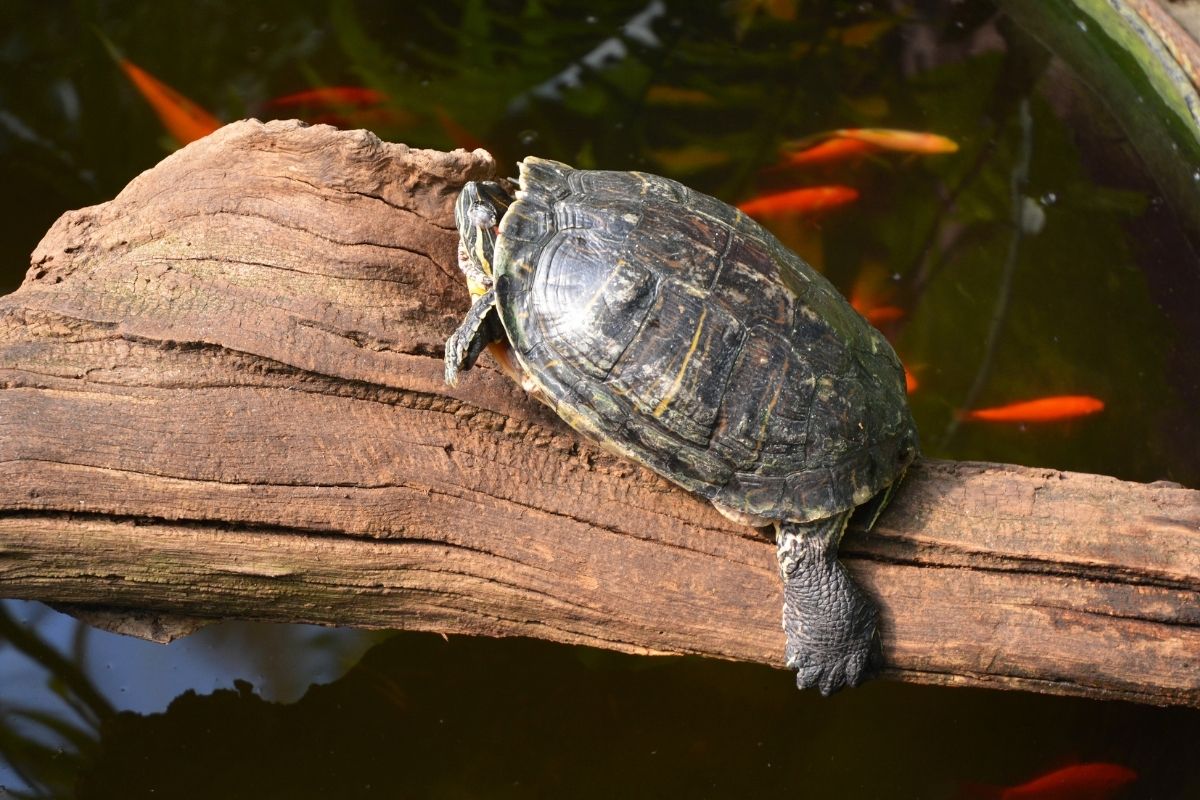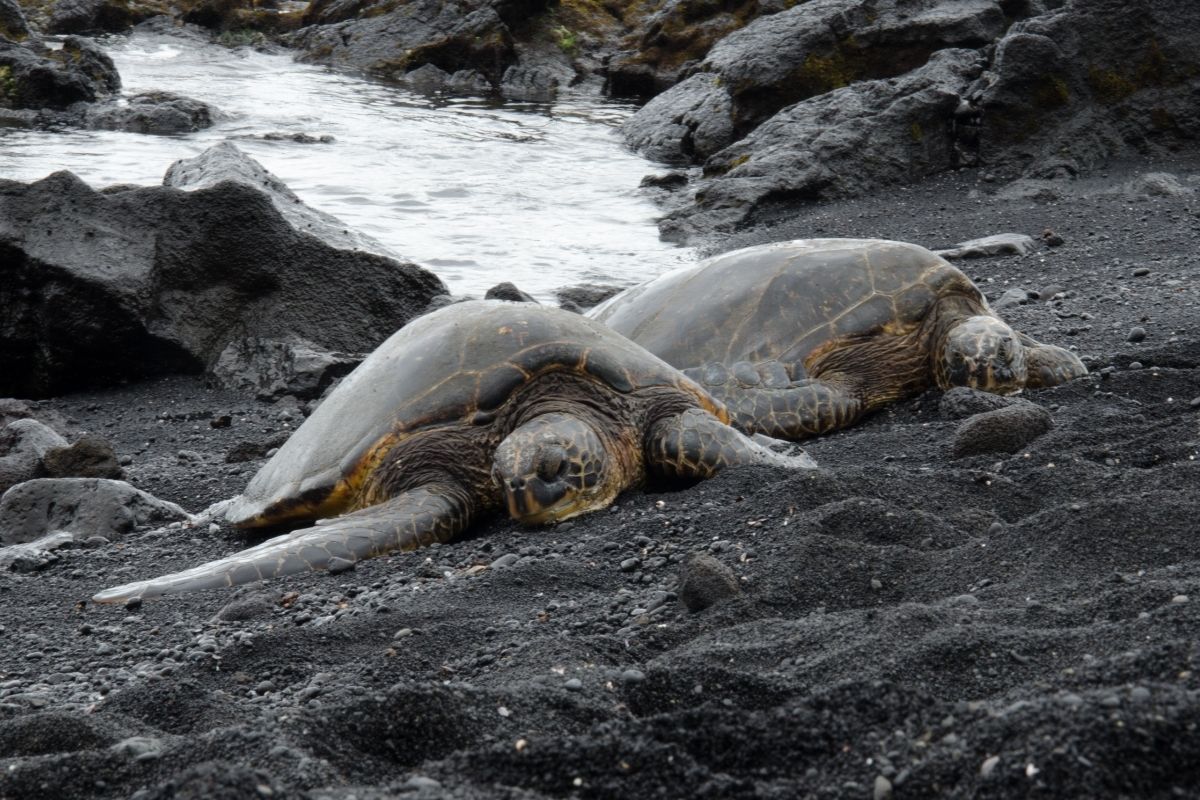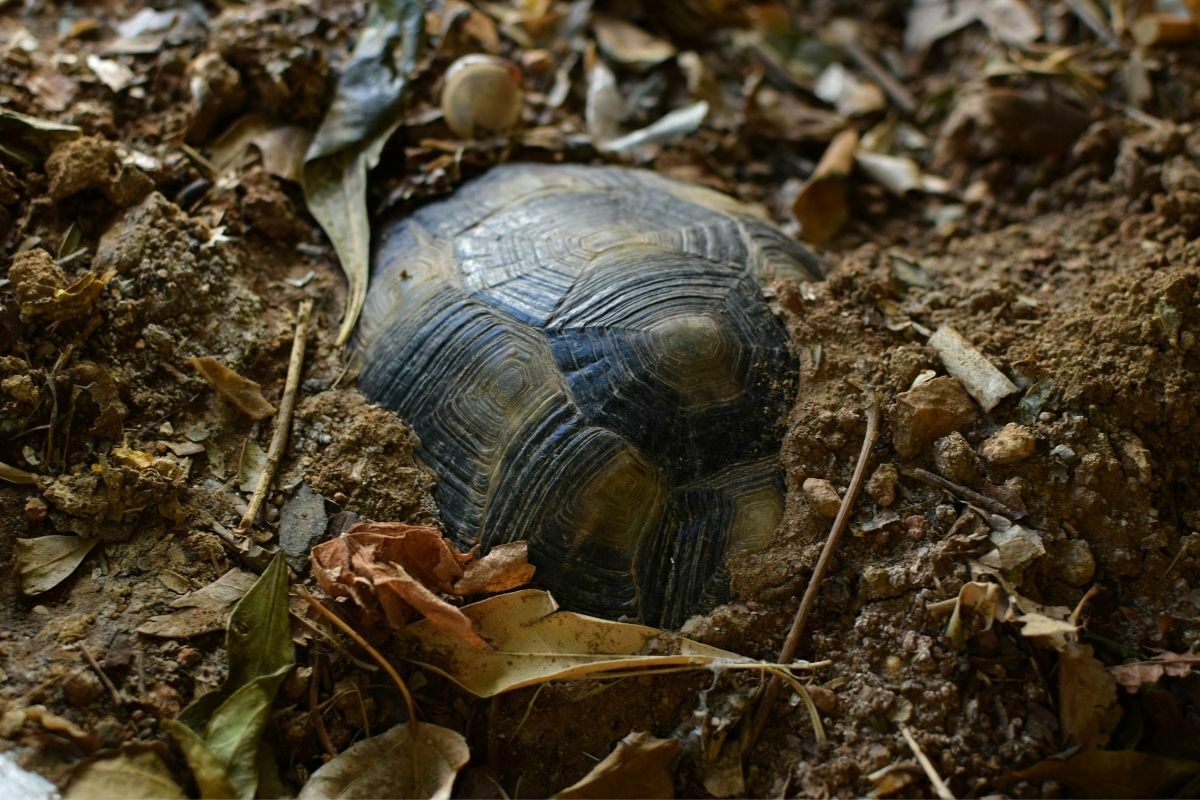Just like any other animal, a turtle needs time to sleep and rest. Like a lot of animals, turtles are diurnal creatures, which means they are active during the day and will sleep at night, just like humans.

For turtles in captivity, you want to maintain a day and night cycle for your turtle.
This means that the lights need to be in your tank for 10 to 12 hours every day and off for the same amount of time. This then follows a natural cycle of day and night that must be followed 24/7.
Alongside that, you must make sure that the water conditions are right for your turtle for when they need to sleep.
In this article, we will be discussing everything you need to know about a sleeping turtle. It is important that a turtle sleeps well, otherwise, they can become stressed and that can affect their health and appetite.
How Does Your Turtle Sleep?
Not all turtles will sleep underwater, some pet turtles will sleep in a place that they find most comfortable.
You will notice that certain turtles like to sleep on the surface of the water, while others will sleep in their basking spot. Compared with other species of turtles that are known to sleep at the bottom of their tank.
Also, some like to float between the bottom of the tank and the surface of the water. There are lots of options for how your turtle may like to sleep. Although, it does depend on the species, as particular species like to sleep a more certain way than others.
However, it doesn’t matter where in their enclosure or in their tank, your turtle decides to sleep. If they are in the water, then occasionally they will need to come to the surface for a breath of air.
Certain species of turtles like the painted turtle and the red-eared slider can actually go for up to 5 hours without needing to come up to the surface for a breath of air. Therefore, turtles can go to sleep under the water.
Turtle species like the sliders, musk turtles, painted turtles, map turtles and mud turtles are all known to sleep under the water.
While species like the box turtles don’t sleep in the water at all. This type of turtle doesn’t like water at all and stays on land, as a result, they need a dry and land-based enclosure. Therefore, they also sleep on the land as well.
Obviously, sea turtles sleep under the water. Aquatic turtles will have a very different sleeping pattern to land turtles and other types of pets you may have.
A land or pet turtle will usually follow the same routine that you have, so they will sleep and wake up when you do.
Compared with an aquatic species of turtle, it will often sleep under the water for around 4 to 7 hours. They then need to come up to the surface so that they have refilled their air supply. Then they can go back to sleep.
Freshwater turtles in the wild like the map turtle are known to burrow themselves in moss or marshy grass to help them sleep.
Some turtles also like to burrow under the ground when they sleep, as this offers them protection from any predators that may be lurking around at night while they sleep.
Alongside this, the North American painted musk turtle and the Japanese pond turtle have the special ability to be able to breathe under the water. This means that they don’t need to come up for air every few hours for more oxygen.
They can stay completely under the water still as they sleep. This is because they can breathe under the water by using cloacal respiration, by using the muscles near the rear of their body.
However, muck turtles use these muscles, which are located under their neck instead. However, when turtles are brumating, a lot of aquatic species of turtles use these techniques to allow them to survive the winter months with little food and little energy.
As oxygen is so important for turtles, you need to make sure that the oxygen levels in your tank are very high. Otherwise, your turtles are going to struggle to be able to receive enough oxygen that they need while they sleep.
If your tank is big enough, then you may want to consider installing a water pump or filter. Then you are assured that there will be enough oxygen in your turtle’s tank while they are asleep.
Do Turtles Always Sleep In The Same Spot?

While some species of turtles do tend to sleep in one spot, it’s not always the case. For example, the box turtle tends to sleep in a nest made out of leaves and twigs.
However, if you keep your box turtle in a large enclosure, it will most likely end up sleeping in many different locations.
However, sometimes a turtle will find a spot that will deem to be the most comfortable, and they may use that as their permanent sleeping area. Therefore, you will then notice your turtle always sleeping in the same spot every night.
As a result, sometimes a turtle will sleep in the same spot, while others may change their mind every night. This differs from turtle to turtle, and it is difficult to give a definitive answer.
Do All Turtles Sleep In Water?
Not all turtles sleep in the water. Many species of turtles prefer to sleep on land. As such, they will usually sleep on a bed of sand or soil. However, some species of turtles will actually sleep in the water.
These include the mud turtle, the soft shell turtle and the leatherback sea turtle.
The mud turtle sleeps in the water because it needs to get rid of its waste products. It does this by excreting through its mouth into the water.
The soft shell turtle has a similar reason for sleeping in the water. It uses the water to cool itself down. It does this by having a layer of fat between its skin and the water. This allows the water to pass right through the turtle without affecting it.
Finally, the leatherback sea turtle also sleeps in the water. Unlike the other two species of turtles mentioned above, it doesn’t need to get rid of any waste products. Instead, it just wants to stay cool.
It keeps its body temperature at around 32 degrees Celsius to achieve this.
When Do Turtles Go To Sleep?
The majority of turtles are diurnal, as we have mentioned above. Therefore, they are active during the day and will sleep at night. Although there are a couple of species that are believed to be nocturnal, this includes the common snapping turtle.
The nocturnal turtles, they will do the opposite and sleep all day and then are much more active in the evenings. However, the majority of pet turtles and turtles in captivity are diurnal.
The reason that the majority of turtles are diurnal is that they need to bask in UVB light. The only time that they can absorb this light is during the day when the sun is out.
However, even when turtles are basking, you may notice them taking a nap during this time as well as they absorb all the important nutrients from the UVB light rays.
How Long Do Turtles Sleep For?
Turtles sleep for different lengths of time. Some species of turtles will go to sleep within minutes of being put in a dark place.
Others will take hours to fall asleep. However, it is known that turtles don’t actually fall into a deep sleep like humans. Instead, for turtles, the process of going to sleep is just a long rest.
For aquatic turtles, they will have to come up for air several times in a night. However, some can stay underwater for around 4 to 7 hours, and they will just bob their head above the water to be able to breathe for those long periods of time.
Some turtles can stay under for such long times, as the temperature is quite low. It should be around 70 to 75 degrees Fahrenheit.
These lower temperatures then affect the turtle’s metabolism and slow it down. Then with a slower metabolism, they need less oxygen so they can sleep for longer without having to come up for air as often.
On the other hand, tortoises can sleep for much longer than a turtle, especially an aquatic turtle.
Some land turtles like the Galápagos Turtle are known to sleep for around 16 to 18 hours a day. Therefore, they are asleep much more than they are awake. They are only really awake when they need to eat.
Is It Possible For A Sleeping Turtle To Drown?
This is not a corner, as a sleeping turtle can go for hours underwater without the need for oxygen and breathing. When a turtle does need oxygen, it will naturally float to the surface.
A turtle could drown only if it gets trapped while underwater. Therefore, you just have to ensure no obstacles could trap your turtle in the tank.
For a baby turtle, it is recommended that the water level is only 2.5 times the height of the baby turtle. This way the baby can resurface easily.
Why Do Turtles Sleep So Much?
Some turtles will rest for long periods of time even when they aren’t sleeping. Although, if your turtle is suddenly resting too much or not being as active as normal, then the temperature may be too low for them and they are being too brutal.
If the temperature is too low, then they will naturally sleep and rest a lot more to conserve their energy.
In the wild, turtles will begin to sleep a lot more as the temperatures begin to drop and winter approaches.
Water temperatures should always be kept at around 70 to 75 degrees Fahrenheit. If the water gets too low, then you may want to consider investing in a water heater that can be regulated with a thermostat.
If you are still worried after making sure the temperatures are all correct, then check with your vet to make sure that nothing is wrong with your turtle.
However, it is important to note that the older a turtle gets, the less active they do become. So as your turtles get older, then get less active and much slower, so they want to rest and sleep more.
Do Turtles Hibernate?

Turtles are known to brumate, which is a turtle version of hibernation during the colder months. However, brumation will occur when the temperature in the turtle’s environment begins to change and get colder.
This is because in the wild food is much more difficult to come by, and so with this cold weather and the lack of food, turtles struggle to hunt and search for food.
Therefore, it is important that they conserve the little energy that they have for when the warmer months come back.
Hence, a turtle will brumate during winter as they need less food and become much less active, so that they can survive and bounce back once the temperature begins to rise again.
Both land and aquatic turtles are known to hibernate/brumate during the colder seasons. However, that doesn’t mean all species of turtles do brumate, but the majority do.
However, turtles in captivity or as pets don’t need to brumate, as they don’t need to preserve any energy as their food is provided to them.
Also as their owners regulate the temperature of their enclosure or tank, they shouldn’t need to prepare for any colder weather. Making your turtle go through brumation has risk as they can die in some situations.
Therefore, if you don’t want your turtle to brumate, then you need to keep the temperature constant and high between 70 and 80 degrees Fahrenheit.
Even during winter, you need to keep these temperatures consistent otherwise your turtle will then begin the brumation process.
Although, if you plan to breed your turtles then you may want to consider putting your turtles through brumation.
Through research, it is known that brumation increases the chances of a successful breeding season. However, you need to be careful if brumation isn’t done correctly then this can lead to drowning, freezing, or starvation.
Tips For Brumation
Not all species of turtle can brumate, it is known that freshwater tropical turtles cannot brumate, so do your research. Ask your vet to look over your turtle before brumation to make sure they think they can survive it, and do your research.
As certain species of turtles can breathe for different periods of time. Some are known to brumate for 6 months, while others only brumate for 2.
Make sure that you prepare a space for your turtle to brumate. Some will brumate in water or in a box.
It is known that some keepers will place their brumation turtles in the refrigerator as they need to stay around 45 degrees Fahrenheit, but they shouldn’t be frozen. Check on them at least once a day.
Also, by opening the fridge door you are letting fresh air into the fire which means that your turtle will still be receiving enough oxygen so that they can survive.
If you do place your brumation turtle in a box, make sure the box has holes so that the turtle has access to oxygen. Also check on the turtle every day, doing your best not to disturb them.
If it is your first time brumating your turtle, then only brumate them for around 3 weeks no matter their age, to make sure they can cope.
For any aquatic turtles, you need to make sure that there are high oxygen levels in the water as they brumate. You can do various things to improve the oxygen levels in the water by using waterfalls or fountains, air stones or filters in a pond.
In a tank, you can use a filtration pump or system that will pump more oxygen into the water. Also, you should be changing the water as often as you can as well.
Finally, you should feed your turtle well in the time leading up to brumation. You want your turtle as well-fed and nourished as possible.
However, some studies have said that you should also fast your turtle in the month leading up to brumation. This will then get rid of any undigested food that is still in the turtle. This also decreases the chances of an infection occurring.
However, you must always make sure that your turtle is well hydrated. Then, once they are ready, you should gradually drop the temperature of their tank or enclosure.
The worst thing you could do is lower the temperature suddenly. You need to do it gradually by dropping the temperature by 1 degree until you have reached the desired temperature for brumation to occur.
Always monitor your turtles’ health. If you notice any health issues or stress, then you may need a vet to look over your turtle. However, make sure the turtle’s environment is clean and well looked after.
Once your little comes out of brumation then you should immediately put them under a heat and light source so that they can wake up.
Also, lukewarm baths will help them out of brumation and bring their body temperature back up.
Final Thoughts
It is known that land turtles and tortoises will spend the majority of their day sleeping. While aquatic turtles will sleep underwater, however, some are known to sleep on the dry land in their basking spot.
Some turtles can breathe underwater while they sleep, and it’s natural for them to sleep near the bottom of the tank. They will float to the surface for air when they need to.
You may notice that your turtle will choose a particular place to sleep and always sleep in that area. Usually, a turtle will sleep for around 4 to 7 hours at night, but they are known to sleep in the day while they are basking too.
If you notice that your turtle is sleeping a lot more than often, then you can assume the temperature of the water or enclosure is too cold, and they are going through brumation.
If the water is below 50 degrees Fahrenheit, then a turtle will naturally start the brumation process. As a result, it is your job to keep the temperature of their enclosures between 70 and 80 degrees to stop this process from happening.
Also, the older your turtles get, the more sleep it will want. However, turtles can live for much longer than humans, although once you’ve had a turtle for more than 10 years then you can expect them to start sleeping for longer periods of time.
We hope this article has given you the answer to all your questions about a sleeping turtle. There are many turtle species out there, and they all have their own different sleeping and brumation habits.
Thus, it is also important to do your best to reach your selected turtle before you try to put them through brumation or if you are worried about their sleeping habits.
Thank you for reading!
